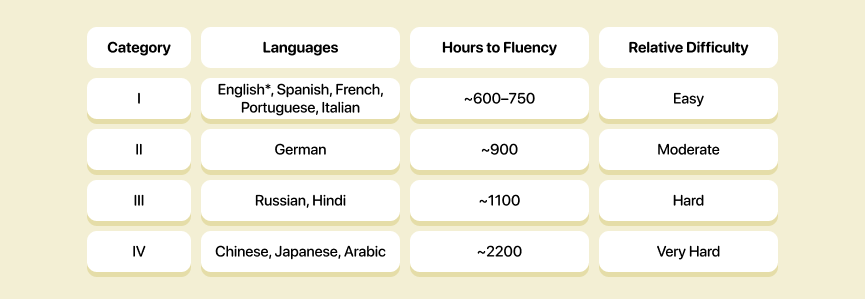Have you ever wondered how long it really takes to learn a language? You're not alone: it's one of the most common questions language learners ask.
We’ve got the real data, comparisons, and friendly advice to help you choose your next language and understand exactly what you’re signing up for.
What Affects Language Learning Time?
Before we dive into hours and charts, let’s get this straight: learning time isn’t the same for everyone.
Some of the factors that matter:
- Your learning method – Full immersion, apps, a weekly class?
- Your motivation and consistency – Are you cramming or committed daily?
- Your definition of fluency – Do you want to travel and chat, or work professionally?
- Your native language – The closer your native language is to your target language, the faster you’ll pick it up.
In short, everyone’s timeline will vary a bit—but the estimates below are backed by data and work as reliable general guidelines.
FSI Language Categories: A Fast-Track Framework
The U.S. Foreign Service Institute (FSI) classifies languages into categories based on how many hours are needed to learn a language to reach professional working fluency (for English-speaking learners). These estimates are based on full-time, immersive study, so casual learners should expect timelines to be longer.

*FSI data is based on English-speaking learners, so English itself isn’t included in their official difficulty rankings because they weren’t studying how hard it is to learn English as a foreign language.
However, we can still reasonably place English in Category I based on extensive global data and comparisons from other trusted sources (like CEFR studies, Cambridge English research, and global learner outcomes).
Now let’s break down each key language in detail.
How Long Does It Take to Learn Spanish?
Spanish is one of the most popular languages to learn, and one of the fastest. It's phonetic, widely spoken, and has a familiar structure for many learners.
FSI category: I
Estimated time:
- Beginner: 100–150 hours
- Intermediate: 250–400 hours
- Fluency: ~600 hours
Why it’s a fast language to learn:
- Regular spelling and pronunciation
- Lots of English-Spanish cognates (animal, hospital)
- Tons of content: music, podcasts, Netflix shows
What slows people down:
- Subjunctive mood and irregular verbs
- Rapid native speech
How Long Does It Take to Learn French?
French is a beautiful, useful language spoken across five continents.
FSI category: I
Estimated time:
- Beginner: 150 hours
- Intermediate: 300–400 hours
- Fluency: ~750 hours
Challenges:
- Nasal vowels and silent letters
- Gendered nouns and verb tenses
What helps:
- Similar vocabulary to English
- Patterns in verb conjugations
- Great media options for immersion
How Long Does It Take to Learn Portuguese?
Spoken in Brazil, Portugal, and parts of Africa, Portuguese is often overlooked, but it’s incredibly rewarding.
FSI category: I
Estimated time:
- Beginner: 120–150 hours
- Intermediate: 300–450 hours
- Fluency: ~600–750 hours
Why it’s easier than expected:
- Shared Latin roots with many European languages
- Phonetic spelling (with regional accents)
Tricky parts:
- Nasal sounds
- Informal speech and slang
How Long Does It Take to Learn English?
English is the world’s most widely studied second language, and for good reason: it’s everywhere in business, tech, and pop culture.
FSI category: I
Estimated time:
- Beginner: 150–200 hours
- Intermediate: 400–600 hours
- Fluency: ~600–750 hours
Why English can be tricky:
- Irregular spelling rules (through, though, tough…)
- Phrasal verbs
- Word stress and pronunciation
Helpful for learners:
- Endless content for practice
- Global access to apps and lessons
- Rich vocabulary from diverse origins
How Long Does It Take to Learn German?
German is precise, logical, and closely related to English, but expect a challenge with grammar.
FSI category: II
Estimated time:
- Beginner: 200–300 hours
- Intermediate: 500–600 hours
- Fluency: ~900 hours
Challenges:
- 4 grammatical cases
- Verb placement rules
- Long compound words
What helps:
- Consistent structure
- Many loanwords from English
- Good learning materials available
How Long Does It Take to Learn Russian?
Russian is rich and expressive, but its grammar makes it one of the more demanding options.
FSI category: III
Estimated time:
- Beginner: 150–200 hours
- Intermediate: 500–700 hours
- Fluency: ~1100 hours
Main challenges:
- Cyrillic alphabet
- 6 noun cases
- Verb aspects
Helpful tips:
- Learn the alphabet early—it’s simpler than it looks
- Practice with slow-spoken podcasts and language apps
- Focus on pattern recognition
How Long Does It Take to Learn Chinese?
Chinese may take longer to learn than most other languages, but the payoff is huge: it’s spoken by over a billion people.
FSI category: IV
Estimated time:
- Basic speaking: 300–500 hours
- Reading & writing (basic): 1000+ hours
- Fluency: ~2200 hours
Challenges:
- Tonal pronunciation (same syllable can have multiple meanings)
- Character memorization (2000+ needed for basic literacy)
- Different grammar and sentence structure
What helps:
- No verb conjugations or articles
- Start with Pinyin to focus on pronunciation
- Use visual memory tools (like Anki or Skritter)
How Long Does It Take to Learn Japanese?
A favorite among anime lovers and business professionals alike, Japanese is a unique and fascinating language.
FSI category: IV
Estimated time:
- Basic conversation: 400–600 hours
- Fluency with reading/writing: ~2200 hours
What makes it hard:
- Three writing systems: hiragana, katakana, and kanji
- Different levels of politeness and formality
- Flexible sentence structure
What makes it easier:
- Simple pronunciation
- No tones
- Logical grammar once the basics are learned
How Long Does It Take to Learn Arabic?
Arabic is one of the most globally important languages, and one of the hardest for many learners.
FSI category: IV
Estimated time:
- Basic conversation: 400–600 hours
- Reading & writing (MSA): 1000+ hours
- Fluency: ~2200 hours
Challenges:
- Written Arabic (MSA) differs from spoken dialects
- New script (written right to left)
- Sounds unfamiliar to most learners
How to manage it:
- Pick one dialect for speaking (e.g. Egyptian)
- Learn MSA gradually for reading and formal settings
- Use subtitles, Arabic YouTube, and beginner books
Fluent vs. Intermediate: What Do These Levels Mean?
So, how long does it take to become fluent in a language? Let’s define some rough stages:

The path isn’t linear. Some people reach an intermediate level quickly, then plateau. Others progress steadily with consistent practice.
The time it takes to become fluent in any foreign language is highly individual. It depends on the language, its category, your consistency, and your goals. But one truth applies to all: You don’t need years of study before you start enjoying your new language.
Speak early. Make mistakes. Stick with it. Language learning isn’t about being perfect, it’s about showing up.
















